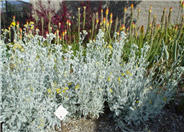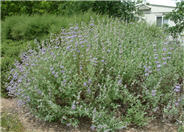
Common name:Chinese Pistache
Botanical name:Pistacia chinensis
The Pistacia chinensis is a deciduous tree with broad, spreading growth to 50' in height. Its leaves have 10-16 leaflets, and the fall coloring arrives in beautiful shades of red, orange and yellow. Prune young trees to shape. This tree does not have edible nuts. Female trees have tiny red fruit, turning dark blue. It prefers full sun and deep, infrequent waterings. This is a great street or park tree.

Common name:Moonshine Yarrow, Milfoil, Sneezewo
Botanical name:Achillea 'Moonshine'
Long, straight stems with pale yellow flowers are striking on the mats of green to grey-green leaves of this plant, which are flatter and less divided than those of the Achillea millefolium. This Yarrow propagates easily from rooted cuttings or divisions which should be performed in the early spring or fall. Following bloom, one should dead head the plant and divide the clumps when it appears crowded. Introduced by Alan Bloom in the 1950's.

Common name:Spanish Lavender
Botanical name:Lavandula stoechas pedunculata
This dense shrub grows 2'-3' tall with blue-grey foliage and deep purple flowers that have large showy bracts in spring and summer near the top of the spikes. It has low watering needs once it's established. It prefers full sun. Foliage is aromatic.

Common name:Cushion Dusty Miller, Silver Ground
Botanical name:Senecio cineraria
The Dusty Miller grows to 2'-3' tall and wide, with velvety gray leaves that have broad, roundish lobes. Yellow flowers heads appear in summer and sometimes, intermittently. Dead head occasionally to encourage bushiness. Use foliage for cut flower arrangements. It prefers full sun and medium amount of watering. It is not frost hardy.

Common name:Cleveland Sage Hybrid
Botanical name:Salvia clevelandii 'Whirly Blue'
'Whirly Blue' is an evergreen shrub that reaches 4' tall and 6' wide. This perennial has fragrant gray foliage and blue flowers that bloom in summer and fall. This shrub needs full sun and prefers well drained soil. This CA native is drought tolerant once it's established. Hummingbirds, bees and butterflies love this Sage. Prune to keep it looking tidy.
| Designer: Robery Boro, Jody Palmer | Rock Art in Garden |
Photographer: GardenSoft |
Soils and Compost:
Practice grass-cycling by leaving short grass clippings on lawns after mowing, so that nutrients and organic matter are returned to the soil.
Water Saving Tip:
Change spray sprinklers to low-flow bubbler or drip systems. Shrubs and trees are ideal candidates for this type of irrigation because the water is applied directly to the root zones.
Integrated Pest Management:
Remove irrigation water and fertilizer from areas where you don't want weeds to grow.
